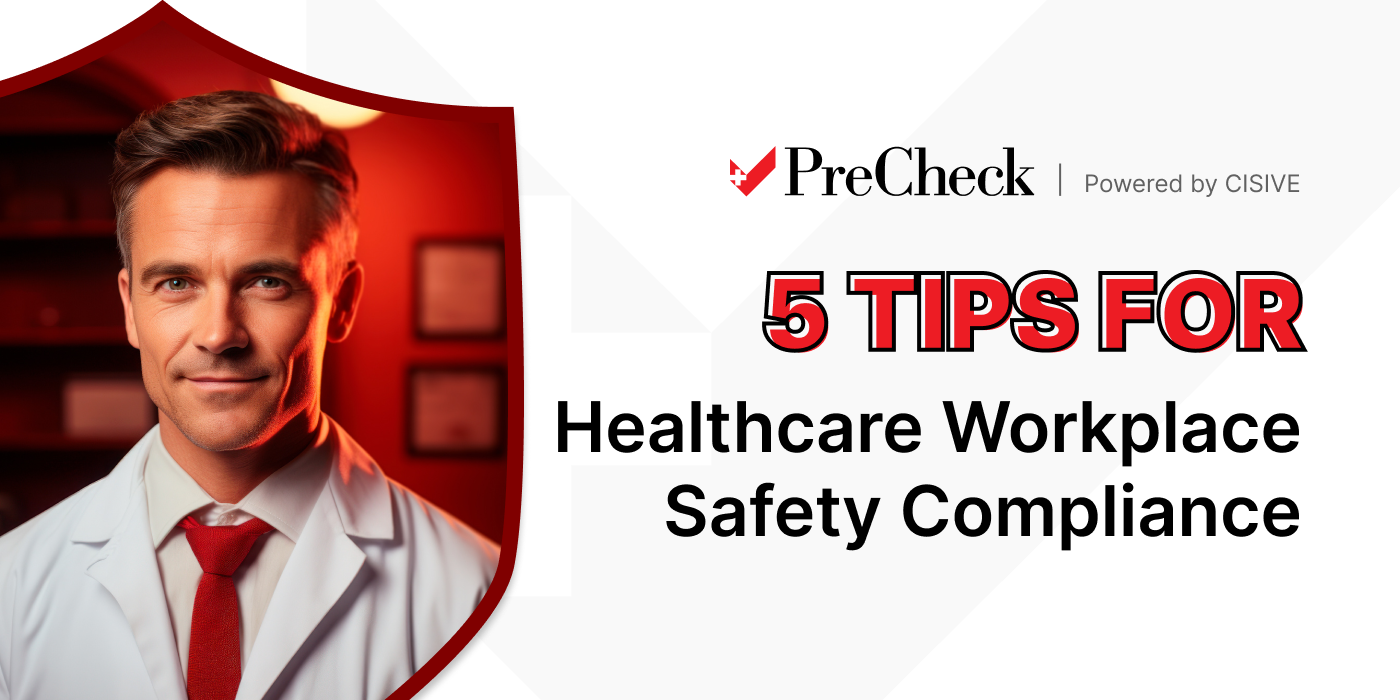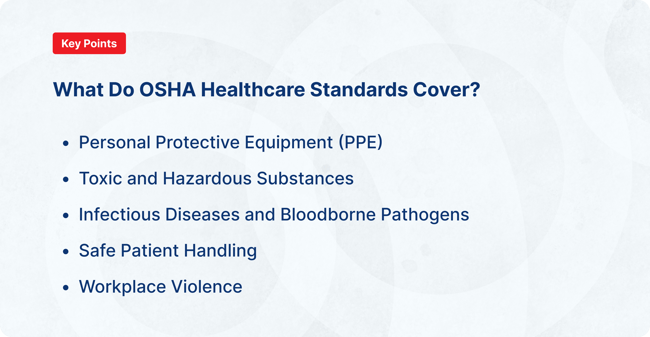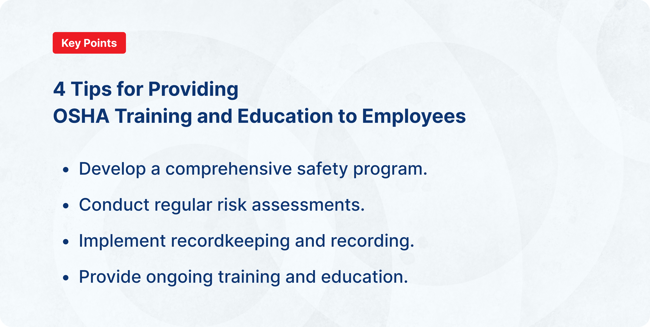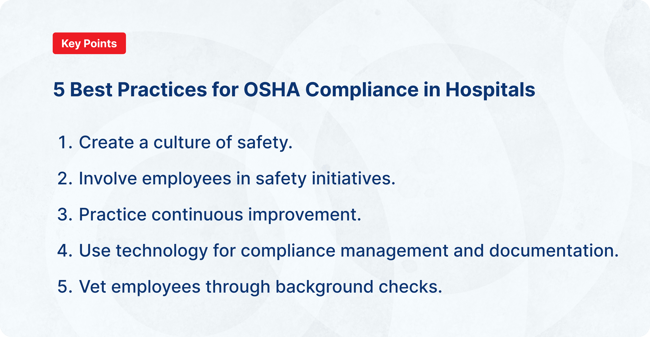

Hiring in healthcare carries a higher standard of responsibility than almost any other field. When...

The Occupational Safety and Health Administration (OSHA) governs workplace safety conditions for most private-sector employers in the U.S. OSHA healthcare compliance involves how healthcare facilities protect worker health and safety while delivering the best possible care.
During the October 2022 to September 2023 period, the most-cited OSHA violations at hospitals were bloodborne pathogens, respiratory protection, formaldehyde, hazardous energy control, and asbestos, respectively. The average penalty across all hospital citations was $29,172, making non-compliance a potentially costly mistake.
Learn how OSHA regulations govern hospitals and other healthcare facilities at the federal and state levels, as well as how healthcare leaders can enact effective OSHA compliance programs.
Top five takeaways:
|
Created out of the General Duty Clause of the Occupational Safety and Health (OSH) Act, OSHA requires employers to establish workplaces that are free of recognized hazards that could lead to serious harm or death to employees. Common hazards seen in hospitals and other healthcare facilities including exposure to infectious materials during routine patient care and the risk of workplace violence from patients.
Because healthcare workers are highly vulnerable to workplace injury and illness, OSHA’s hospital and healthcare standards lay the groundwork for protecting worker safety. Following these standards keeps your healthcare organization in compliance and your workforce safe.

Leading threats to healthcare worker health and safety include exposure to communicable diseases, toxic substances, bloodborne pathogens, bodily fluids, and violent outbursts from patients or colleagues. OSHA healthcare standards cover each of these scenarios, among others, providing a framework for employee safety.
OSHA requires employers to provide personal protective equipment (PPE) to healthcare workers who might be exposed to diseases and other hazards. PPE in healthcare can include specific types of masks, gloves, safety glasses and full-body suits.
In addition to providing PPE, employers must educate team members about:
This OSHA requirement is relatively easy to satisfy because PPE is standard in most healthcare settings. However, PPE shortages can complicate your compliance. During the COVID-19 pandemic, many healthcare facilities ran short on PPE, creating additional risks for healthcare workers treating coronavirus patients or working near them.
Since then, the National Institute for Occupational Safety and Health, under the guidance of the Centers for Disease Control and Prevention, released recommendations for conserving PPE supplies during a shortage.
Under OSHA standards, toxic and hazardous substances generally refer to chemical substances that pose “health hazards (such as irritation, sensitization, and carcinogenicity) and physical hazards (such as flammability, corrosion, and explosibility).” Common chemicals in healthcare settings include ethylene oxide, formaldehyde, and glutaraldehyde, all of which are used for sterilizing medical equipment.
Healthcare workers can be exposed to other safety and health hazards, including drugs, radiation, bodily fluids, and waste products.
OSHA’s hazard communication standard falls under broader guidelines on toxic and hazardous substances. It covers the safe classification and labeling of toxic or hazardous materials, preventing confusion about or the misuse of dangerous products. Hazard communication also includes:
OSHA’s infection control standards help protect healthcare workers from diseases that may be passed through:
PPE, along with basic hygiene, sanitation, and sterilization practices are among the top defenses against the spread of infectious diseases.
OSHA’s bloodborne pathogens standard falls under the infectious diseases category. These risks include exposure to HIV and hepatitis B and C, which can be passed through blood. The bloodborne pathogens standard also covers needlestick safety, including how to use and dispose of needles and how to minimize injury from and exposure to contaminated needles.
Healthcare roles are physically demanding, often requiring clinical workers to physically handle patients. This adds to the risk of healthcare workers suffering musculoskeletal disorders and injuries. Transferring or repositioning patients is classified as an ergonomic hazard, as these activities can result in sprains and strains, most commonly in the shoulders and lower back.
Workers in long-term care facilities, acute care settings, and home health roles, as well as physical therapists, radiologists, and sonographers, are at highest risk of these injuries.
These injuries are so common among healthcare workers that OSHA has released specific guidance on safe patient handling. OSHA offers guidance on creating patient-handling policies and investing in equipment to support workers moving patients, for example. The agency also urges employers to conduct a needs assessment for each patient, among other recommendations.
Healthcare settings can be at risk of violent incidents, whether from patients, workers, or other people present. In fact, healthcare workers endured 76% of all intentional workplace injuries reported in 2020, according to Bureau of Labor Statistics data.
OSHA suggests that healthcare facilities enact zero-tolerance policies to help protect workers from harassment, abuse, or assault. Additionally, OSHA suggests developing a workplace violence prevention program to identify risk factors and proactively protect workers.
While patients commit most healthcare workplace violence, bullying among employees is also common. According to a report from the American Medical Association, bullying and mistreatment is more likely when healthcare facilities are understaffed, overworked, poorly managed, and stressful.
There are 21 states, plus Puerto Rico, with state-level OSHA plans that cover private- and public-sector employees. Six states and the U.S. Virgin Islands have state-level plans that apply only to public-sector workers. State-level plans can enact rules, regulations, and penalties that go beyond federal standards, although they must be as effective as OSHA in preventing work-related incidents, including deaths.
The maximum OSHA penalty for serious violations, other-than-serious violations, and posting violations is $15,625 per violation, although other-than-serious violations don’t necessarily require a financial penalty.
Willful or repeated violations come with a penalty of at least $11,162 per violation and no more than $156,259 per violation. Again, the monetary penalties for other-than serious violations can be less, even for willful or repeated violations.
Employers that fail to abate, meanwhile, can be fined $15,625 per day for each day past the abatement date. This ongoing fine is usually limited to no more than 30 days.

The best way to maintain compliance with OSHA guidelines is to build them into your policies and protocols. To protect your healthcare workforce, establish a safety program, monitor risks, document threats to health and safety, and keep workers trained on the latest safety procedures.
Establish a safety committee or assign a safety officer who'll oversee the OSHA safety program.
Implement a hazard communication program to ensure proper labeling, storage, and handling of hazardous chemicals. Develop protocols for handling and disposing of biohazardous materials, such as blood and bodily fluids.
Develop written safety policies and procedures that address relevant OSHA standards. A policy on safe needle handling, for example, should cover:
Conduct an initial assessment of healthcare facilities to identify potential hazards and risks. After this assessment, develop policies to address immediate risks and safety gaps, as well as improve overall worker protections.
From there, conduct regular audits to continuously identify and address safety concerns. Make sure your safety policies and procedures evolve to reflect changes in regulations, industry best practices, and emerging hazards.
Establish a system for reporting and investigating workplace incidents, injuries, and near-misses. This information helps identify trends, root causes, and areas for improvement. Keep records of safety training, inspections, incidents, and any corrective actions, as these can be useful for demonstrating compliance during OSHA inspections or as evidence should litigation occur.
Provide training to employees on OSHA regulations, hazard recognition, and safe work practices. Training gives workers the skills and vocabulary to identify hazards, use safety equipment properly, and respond effectively to emergencies. Ongoing training reinforces these lessons while giving employees the latest knowledge and best practices.

Rules and policies are necessary but insufficient for workplace safety. Workers need to understand why such rules exist and why they should be motivated to follow them. Here are best practices for getting employees engaged with safety precautions and compliance.
All levels of your healthcare organization need to emphasize worker and patient safety, but establishing this culture starts at the top. Make sure that leaders — especially physician leaders — are following safety protocols and visibly engaging in positive behaviors, such as pursuing safety certifications and recognizing employees who spot potential issues.
One of the best ways to shape a culture of safety is to involve employees in safety initiatives, including soliciting their input. Establish effective communication channels to share safety information, policies, and procedures, as well as to learn from them what’s working and what could be improved
Comprehensive, ongoing safety training can help employees at all levels understand what’s at stake while giving them the knowledge required to identify and reduce risks.
Foster a culture of continuous improvement by regularly evaluating safety performance. Implement employee feedback and make updates based on new information, updated regulations, and lessons learned.
Technology is essential for accurate, organized, and easily updated records of safety training, incident reports, inspections, and corrective actions. Online training platforms can help you deliver and track safety training for employees with ease and without disrupting regular work patterns. A tool like PreCheck’s LicenseManager Pro can help you track safety training requirements so you can better maintain health and safety compliance.
One way to reduce OSHA risks in your healthcare facilities is by hiring people who have a track record of safety. Employment verifications and background checks can help. Background screenings protect patients and staff from potential harm or abuse by flagging job candidates or employees with a history of violent or criminal behavior. Additional verifications, such as those related to drug screening and occupational health, can help employers make hiring decisions with minimal risk.
A strong background check policy signals that safety is a priority in your culture. Work with a healthcare-specific background check partner such as PreCheck to vet employees appropriately, consistently, and thoroughly.
OSHA compliance is a crucial component of providing the highest standards of safety and quality in healthcare settings. Organizations must stay current with OSHA regulations, conduct regular training, and use technology for compliance tracking and documentation. Doing so helps healthcare organizations meet regulatory requirements while creating a culture of safety that reinforces best practices for worker and patient safety. By creating a safer workplace, you also improve patient care, reduce liability risk, and deliver better outcomes.
Ultimately, committing to OSHA compliance in healthcare is integral to an overall commitment to excellence in healthcare delivery. A background screening partner with expertise in the healthcare industry is your first step toward ensuring you have the right employees in place to follow these regulations and keep your organization compliant.
Want to learn more? Schedule a call with one of our background screening experts.

Hiring in healthcare carries a higher standard of responsibility than almost any other field. When...

Healthcare is one of the most heavily regulated industries in the world, so you need to be aware of...

Healthcare background check compliance is a critical component of the hiring process. Who you hire...